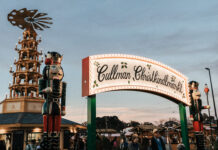
On Sunday, Dec. 1 (technically at sundown on Nov. 30), Christians of older traditions in the western world entered the season of Advent, an ancient 40-day period of preparation leading up to Christmas. The word comes from a Latin term meaning “coming” or “arrival,” and was used in the Roman world for the arrival of the emperor at home or another location after a military victory. Advent is commonly observed by Catholics, Anglicans, Episcopalians, Lutherans and some Presbyterians and “high church” Methodists; certain elements have grown in popularity even in evangelical Protestant denominations.
The traditional purpose of Advent is to build anticipation for the celebration of Christ’s coming at Christmas, for which the Church reaches back to the teaching of the prophets from the Old Testament era through the ministry of John the Baptist, and to develop a sense of expectancy for the second coming of Christ at the end of time.
The Catechism of the Catholic Church says, “When the Church celebrates the liturgy of Advent each year, she makes present this ancient expectancy of the Messiah, for by sharing in the long preparation for the Savior’s first coming, the faithful renew their ardent desire for his second coming.”
The Episcopal Dictionary of the Church says, “The season is a time of preparation and expectation for the coming celebration of our Lord’s nativity, and for the final coming of Christ ‘in power and glory.’”
The United Methodist Book of Worship says, “The season proclaims the comings of the Christ—whose birth we prepare to celebrate once again, who comes continually in Word and Spirit, and whose return in final victory we anticipate. Each year Advent calls the community of faith to prepare for these comings . . .”
Thinking about God coming to earth as a man in the person of Jesus Christ is a theological subject known as the incarnation. For Fr. Patrick Egan, senior pastor of Sacred Heart of Jesus Church, understanding what it means for God to become human is crucial to the experience of Advent.
Egan told The Tribune that there are three valuable things Christians can learn or be reminded of during Advent:
“The first one is, it would introduce them to the concept of the incarnation, that God who made us–made all things–became one of us in the person of Jesus. That is the key difference between Christianity and every other religion, is that we say God became one of us.
“I think the second thing is, it reminds us that we have a creator God. We’re not our own gods; we were created in His image, and that we owe Him our fealty and love.
“And I think the third thing is, He is a God of mercy and love, and He gave us free will which we have continually abused. I think somebody told me today Jean-Jaques Rousseau had a saying, said that God gave man free will and man threw it back at Him. And that’s where we live, so it reminds us that, not only are we not God, we can’t even control ourselves without Him. And the reason He came in the incarnation is to show us what it means to be human and, not only what it means to be human, (but also) how to be human. And then He rewards us, if we follow His teachings, with everlasting life.”
Popular Advent practices
Evergreen decorations – Perennial plants like evergreens are said to symbolize eternal life, and both church buildings and private homes are commonly decorated with things like pine branches and holly, either informally or in a ceremony often termed “hanging of the green.” The Christmas tree or, more recently, the Chrismon tree is usually the primary evergreen decoration.
Advent wreath – The use of an evergreen wreath and candles to mark the weeks (and, at times, even the days) of Advent seems to have originated with Lutherans in Germany, but has become a common feature of December Sunday services across all denominations. Four candles are lit, one each week, representing (in order) hope, peace, joy and love. At the close of Advent on Christmas Eve, usually after sunset (when in traditional liturgical calendars Christmas Day begins), a large white candle is lit in the center of the wreath, representing the arrival of Christ as the light of the world. The wreath has become a seasonal staple on its own, commonly found on doors and in windows.
Advent calendar – Counting down the days until Christmas using a calendar, often reusable from year to year, has become a widespread practice to build anticipation among children. The marking of the calendar is often accompanied by personal or family devotions.
Copyright 2019 Humble Roots, LLC. All Rights Reserved.






























